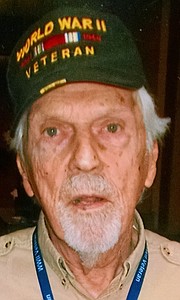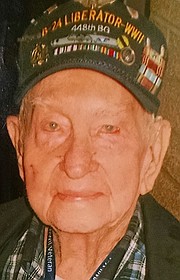Air Force reunion the bomb for vet
By BRIAN WALKER
Staff Writer
COEUR d'ALENE — Johnny Bryant hit a gold mine of fellow veterans when he attended a reunion of World War II bomber pilots.
The Air Force veteran from Coeur d'Alene chronicled as many war stories as he could last month during the reunion of the Eighth Air Force members in Dayton, Ohio.
"Attending this was something I've always dreamed of because I wanted to sit down and talk with them," said Bryant, one of just two people from Idaho to attend the event. "It was very touching. There were 51 Eighth Air Force at this year's reunion, which was down from 75 last year."
It was an event Bryant will forever cherish, especially since the World War II vets are in their 90s and a few are older than 100.
Bryant, who served in the Air Force from 1986 to 2006 with tours in Sicily, Turkey, Italy and Holland, said he wants to honor as many World War II vets as possible before moving on to visit with veterans of more-recent wars.
In Italy, Bryant participated as a munitions systems specialist in Operation Deny Flight that enforced a no-fly zone over Bosnia, preventing Serbia from making air strikes.
Therefore, at the reunion, Bryant was in his glory meeting the likes of B-17 bombardier Teddy Kirkpatrick. Kirkpatrick is the only surviving member of more than 5,000 U.S. Army Air Force personnel who served at his airfield in Kimbolton, England.
"Last year he contacted the airfield director at his old airfield and told them he was coming for a visit," Bryant said. "He was put on a World War II Willys Jeep and paraded through every village within 20 miles of his airbase.
"He received the total General Patton treatment. Every village had their streets lined with civilians to be able to meet a World War II hero who is the last of a few."
Tail gunner Dewey Holst described how a shell exploded below the B-24 he was in during a mission to Germany and it started fires in two engines.
"Knowing that (the navigator and Holst) could not make it back to England, they stayed with the B-24 until they reached the bailout altitude of 1,500 feet and jumped," Bryant said. "Fortunately they both lived and the area they landed on had been vacated by Germans less than 24 hours earlier."
Donald O'Reilly, a security forces specialist, shared that one of the squadrons at his base in Chelveston, England, was tasked with dropping propaganda leaflets over the Germans in France, Holland and Belgium. A friend from a B-17 crew asked if O'Reilly would like to come along at night to help out.
"Sure enough, they had a flight suit for him whenever he wanted to go up," Bryant said. "After lights out, he would slither out of his barracks and go up with them. When they arrived back, he would sneak back in his barracks as if nothing had ever happened."
Bryant said O'Reilly told him that he estimates he went on at least 50 such missions.
The conversations with the vets — Bryant spoke with 10 of the 51 — drove home the courage they had to fly at a young age, he said.
"Most of the gunners were 18- and 19-year-old kids and the navigators were 21 to 24," he said. "To have to go through something like that at such a young age is what really stuck out to me."
The trip was Bryant's latest venture in honoring World War II veterans. It came on the heels of his visiting 66 airfields and 34 museums in England — all last year. He plans to return to England in 2020 to pay his respects to the Royal Air Force and Ninth Air Force at 32 other sites.
"I'm addicted to history," he said.
Before Bryant's trip to the Eighth Air Force reunion, which also included visits to multiple air museums in the Midwest, he flew in a B-17 out of Spokane International Airport last summer.
"It was quite an experience," he said, adding that a 71-year-old grandmother helped navigate the plane that day. "I wanted to fly in one to know what these (World War II pilots) experienced. And, to think these guys went on missions from eight to 11 hours is amazing."
Bryant said he is mesmerized at the skill and devotion pilots showed.
"These guys took off on a 6,000-foot runway fully loaded with bombs into fog and every 30 seconds behind you there'd be another one," he said. "They'd use a watch for their timed turns because there were not instruments back in those days.
“These guys were special. They put their lives on the line so we can do what we want freely."







